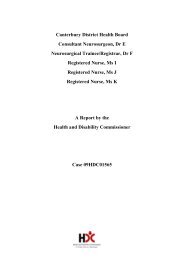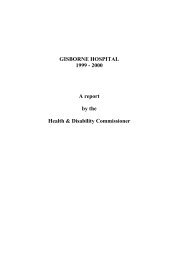Download the pdf version of this decision. - Health and Disability ...
Download the pdf version of this decision. - Health and Disability ...
Download the pdf version of this decision. - Health and Disability ...
Create successful ePaper yourself
Turn your PDF publications into a flip-book with our unique Google optimized e-Paper software.
<strong>Health</strong> <strong>and</strong> <strong>Disability</strong> Commissioner<br />
Information reviewed<br />
Information provided by:<br />
• Mr <strong>and</strong> Mrs A<br />
• Dr B<br />
• Ms D (midwife)<br />
• Dr C<br />
• A District <strong>Health</strong> Board<br />
• ACC<br />
Independent expert advice obtained from Dr Michael East, obstetrician.<br />
Information ga<strong>the</strong>red during investigation<br />
Background<br />
Mrs A was under <strong>the</strong> care <strong>of</strong> obstetrician Dr C <strong>and</strong> midwife Ms D for her second<br />
pregnancy in 2001. Mrs A had experienced complications during <strong>the</strong> birth <strong>of</strong> her first<br />
daughter in 1998. That labour was induced because <strong>of</strong> Mrs A’s high blood pressure.<br />
She failed to progress beyond 5cm after 19 hours <strong>of</strong> labour, resulting in a delivery by<br />
emergency Caesarean section due to early warning signs <strong>of</strong> fetal distress. With <strong>this</strong><br />
clinical history, Dr C <strong>and</strong> Mrs A discussed <strong>the</strong> risks <strong>and</strong> benefits <strong>of</strong> attempting a<br />
vaginal delivery, <strong>and</strong> Mrs A agreed to a trial <strong>of</strong> labour.<br />
Dr C planned to take a period <strong>of</strong> leave in February 2001 <strong>and</strong> arranged for his<br />
colleague, Dr B, to provide cover for his maternity patients during <strong>this</strong> time. Mrs A<br />
was aware <strong>of</strong> <strong>this</strong> arrangement to cover Dr C’s absence. Dr C advised ACC that<br />
during his h<strong>and</strong>over he provided Dr B with a verbal report, Mrs A’s antenatal card<br />
<strong>and</strong> a h<strong>and</strong>written note (which is no longer available).<br />
Early signs — 10 February 2001<br />
Mrs A went into early labour on 10 February 2001. She experienced a spontaneous<br />
rupture <strong>of</strong> membranes at home at about 0830 <strong>and</strong> called Ms D at 0852. Ms D advised<br />
her to go to <strong>the</strong> delivery suite at a public hospital for assessment. Ms D met Mrs A at<br />
<strong>the</strong> hospital at 0955 <strong>and</strong> confirmed that Dr B would be providing obstetric care as Dr<br />
C was still away. Mrs A was not yet experiencing contractions, <strong>and</strong> <strong>the</strong> baby was<br />
noted to be in <strong>the</strong> occipito-posterior position. 1<br />
1 That means <strong>the</strong> back <strong>of</strong> <strong>the</strong> baby’s head is towards <strong>the</strong> rear <strong>of</strong> <strong>the</strong> pelvis. This is back-to-front from<br />
<strong>the</strong> normal lie <strong>of</strong> <strong>the</strong> fetus.<br />
2 19 September 2006<br />
Names have been removed to protect privacy. Identifying letters are assigned in alphabetical order<br />
<strong>and</strong> bear no relationship to <strong>the</strong> person’s actual name
















